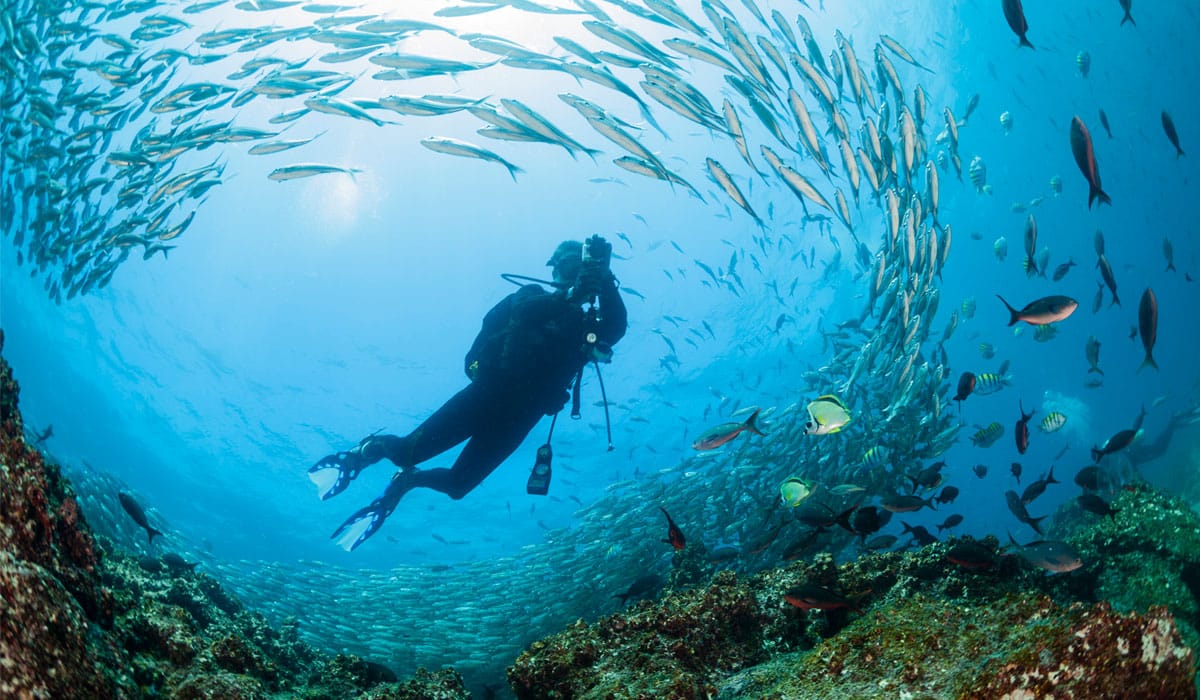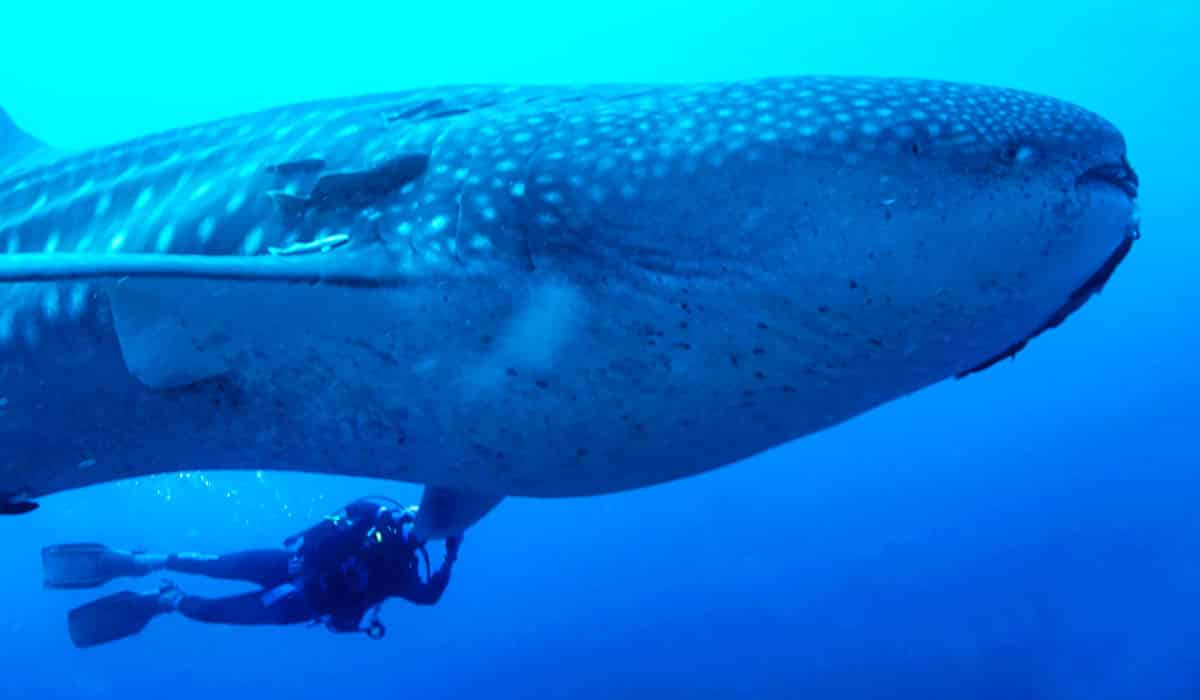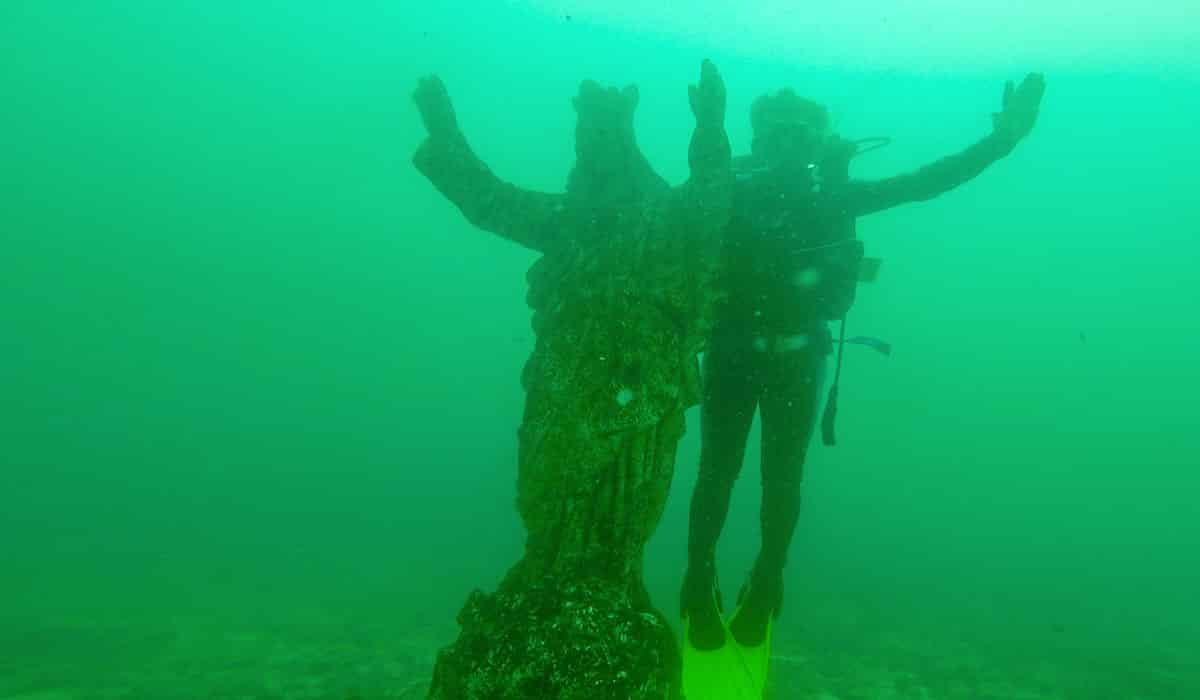Without a doubt, Ecuador and the Galápagos Islands are often seen as two of the biggest destinations on any scuba diver’s bucket list. The coastal mainland and the archipelago are each an underwater paradise, packed with their own unique set of sea creatures and aquatic features. Let’s review some of the best spots to go diving in Ecuador!

Given that the Galápagos Islands can only be accessed by flying to mainland Ecuador first, it would be somewhat remiss of any scuba diver to not enjoy the beautiful, laid-back atmosphere of the mainland beaches, either before or after experiencing the Enchanted Isles.
While dive sites in Ecuador and the Galápagos might not offer the incredible underwater coral landscapes of the Great Barrier Reef, it’s really the collection of magnificent species that frequent these waters—largely due to nutrient-rich currents—that make them such a special and sought-after pair of scuba diving destinations.
Keep in mind that each of these offers its own set of experiences and costs, too. This blog will give you a clearer sense of what to expect from each.
Where and How to Enjoy Diving in Ecuador
The coastal region of mainland Ecuador offers numerous places to dive along its beautiful beaches. However, some of these spots are routinely overshadowed by the popularity of the Galápagos Islands, which tend to draw the greatest interest on behalf of scuba divers around the world. Ultimately, one could say that Ecuador’s coast offers a more beginner-and-intermediate-level experience, while the Galápagos cater more towards seasoned, expert divers.
The central region of Ecuador’s coast is where divers tend to visit in order to live a more laid-back experience of the country’s underwater ecosystems. More often than not, visitors travel to diving towns along the Pacific Coast to dip their toes into the scuba diving world for the very first time and get certified.
The Galápagos Islands, however, require a high-level of experience that will often need to be validated by reviewing your dive log and the number of dives you’ve made in a set length of time prior to your arrival in the archipelago. Oftentimes, this makes it hard, if not impossible, for newcomers to the scuba diving scene to venture out (aboard liveaboard cruises) to the iconic, faraway diving sites in the archipelago that are often teeming with hammerhead and whale sharks.
That said, visitors can still try out beginner-level diving sites that are relatively close to the major towns of Puerto Ayora and San Cristóbal in the Galápagos. For those looking to get certified, Galápagos also offers an ample array of scuba diving operators that offer two- or three-day training programs.
Best Time of Year for Diving in Ecuador
The best time of year to go scuba diving in Ecuador tends to be between November and April. Water temperatures are at their warmest during this time, 64°–73°F (or 18°–23° C), and the currents are often calmer, too. However, many dive sites are not immune to the presence of strong currents and pockets/surges of cold water (which can sometimes drop to as low as 50° F (10° C).
Wetsuits will often be required, especially in the Galápagos, where a full wetsuit will be used on nearly all diving tours. Visibility will typically range between 10 ft (3 m) at worst and 20–79 ft (6-24 m) at best.
In the case of the Galápagos, nutrient-rich deep-sea upwellings and currents that occur between June and December ignite the archipelago’s waters with the arrival and elevated activity of numerous marine species.
Diving in Ecuador’s Paradise—The Galápagos Islands
Not only are the Galápagos Islands a UNESCO World Heritage Site, but they are also a Marine Reserve. This means that tour operators, and even commercial fishing operations, are highly regulated and monitored by the Ecuadorian government.
This gives visitors a special peace of mind in knowing that they are, indeed, experiencing a paradise, which attempts to respect and not interfere with nature as much as possible.

The most renowned and challenging dive spots in the Galápagos are found up in the northern region, particularly by Wolf Island and Darwin Island, which are only accessible via liveaboard diving cruises. These diving sites are home to the jaw-dropping groups of hammerhead sharks, as well as the occasional presence of behemoths in the form of whale sharks.
Keep in mind that there is a substantial trade-off to experiencing scuba diving aboard a liveaboard cruise—visitors only get to enjoy the underwater wonders of the Galápagos, as these cruises are not allowed to have their passengers disembark on any of the islands (save for the principal port towns).
Scuba diving day tours in the Galápagos are still available and offered from the principal populated centers of Puerto Ayora on Santa Cruz Island and Puerto Baquerizo Moreno on the island of San Cristóbal. Diving sites available on these day tours are relatively nearby and cater to divers of all experience levels.
Diving Along Ecuador’s Mainland
The most popular diving sites on mainland Ecuador exist along the central portion of its coast. It is worth noting that divers that opt to dive along Ecuador’s coast will find themselves with day tours rather than liveaboard cruise options.
However, this allows divers to enjoy the beauty and tranquility of the laid-back towns that adorn Coastal Ecuador and serve as a jumping-off point for several nearby, iconic dive sites such as the following. Read on to find out what to see underwater!
Isla de La Plata (from Puerto López)
Nicknamed “the poor man’s Galápagos”, Isla de La Plata offers divers the chance to view several iconic species from the Galápagos, such as blue-footed boobies and colossal frigatebirds, before heading underwater and hanging out with playful sea lions or marveling at whitetip reef sharks, in addition to sea turtles and countless tropical fish. This is quite possibly one of the most popular diving destinations in all of Ecuador.
Islote El Pelado (from Ayangue)
A part of the El Pelado Marine Reserve, El Pelado Islet is a great place to enjoy some pretty fantastic scuba diving off the coast of Ecuador. El Pelado (meaning “peeled” or, more colloquially, “bald” in Spanish) gets its name from the fact that the island is devoid of any vegetation.

Islote El Pelado is a popular spot for blue-footed boobies, frigates, seagulls, and sea lions that lounge around its terrain. Its true call to fame lies in what you’ll find underneath the water’s surface—another universe, teeming with natural reefs and a spectacular variety of fish! Divers will get to experience all of this at any one of the 12 dive sites in the immediate vicinity of the islet.
Bajo Copé (from Ayangue)
Bajo Copé sits about an hour away from the coastal town of Ayangue, and can only be reached by using GPS or sonar. Why you might ask? Because Bajo Copé consists of an enormous swath of ocean (approximately 6 mi2 or 10 km2), where divers are treated to a diverse array of fish, coral reefs, and the famous giant manta rays (typically seen between July and September) for which this diving site gets its nickname: “The Giant Manta Ray Capital”.
Diving Courses in Ecuador
Many of the dive sites listed in this blog offer diving courses for newcomers to experience the submarine universe of Galápagos and Mainland Ecuador. To take your pick, assess your skills first. If this will be your very first lesson, stay close to the continent. If you have more advanced training, you can venture into the wondrous archipelago of the Enchanted Isles.
The warm currents and easy weather of the mainland make for a safe and stable environment for beginners to become initiated in the world of scuba. Puerto López is the most popular, closely followed by Salango, Isla de La Plata, and Ayangue. The general area of Machalilla is a scuba diving gold mine, thanks to its Catagallo Marine Reserve.
Given the Galápagos Archipelago’s volcanic geography, it is best to leave this scuba-diving gem for when you’ve gathered more experience. In the Galápagos, you’re bound to dive next to rocky cliffs and swim with sea turtles, which requires a bit more experience with scuba equipment, mixed currents, and greater depths.
No matter how and where you ultimately decide to go scuba diving in Ecuador, you will be sure to have an extremely memorable time!


